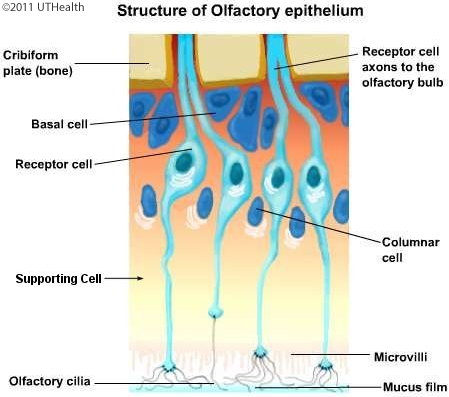Lab 7 (ƒ6) - Auditory, Vestibular, Gustatory and Olfaction Systems
The Olfactory System - Introduction
 Although the olfactory receptors cannot be clearly differentiated in this figure, you should be aware of their general structure. The olfactory epithelium contains the bipolar olfactory cell, supporting cells and basal cells.
Although the olfactory receptors cannot be clearly differentiated in this figure, you should be aware of their general structure. The olfactory epithelium contains the bipolar olfactory cell, supporting cells and basal cells.
In stained sections the supporting cells cannot be differentiated from the olfactory cells that they surround. However, the nuclei of the olfactory and supporting cells can be seen forming staggered rows within the olfactory epithelium. The receptive portion of the olfactory cell (i.e., its peripheral process) forms a long "neck" that passes towards the nasal air passage. Recall that this process terminates as an olfactory knob that gives rise to numerous olfactory cilia. The cilia can be seen in microscopic slides as small tufts in the mucus film which separates the superficial surface of the olfactory epithelium from the air space, i.e., in the light area located adjacent to the nasal air passage.
At the opposite end of the olfactory cell, the olfactory axon, passes through the layer of basal cells and forms bundles called the olfactory fila. The nuclei of the basal cells can be seen lining the olfactory epithelium.
